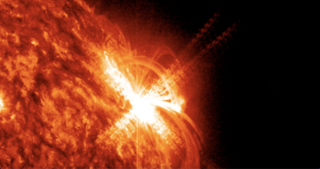The sun blasted out a superpowerful X-class flare on Friday afternoon (March 3), and a NASA spacecraft captured footage of the dramatic event.
The solar flare — an intense burst of high-energy radiation — erupted Friday at 12:52 p.m. EST (1752 GMT). It registered as an X2.1, NASA officials said, meaning it was particularly intense. (Solar scientists categorize potent flares into three categories, with C being the weakest, M being medium-strength and X the most powerful.)
The power of Friday's flare is on full display in footage captured by NASA's Earth-orbiting Solar Dynamics Observatory (SDO), which has been studying the sun in detail since 2010.
Related: The worst solar storms in history

Radiation from the flare, which erupted from a sunspot called AR 3234, caused a shortwave radio blackout over North and South America, according to SpaceWeather.com.
"Aviators and ham radio operators may have noticed loss of signal and other unusual propagation effects at frequencies below 30 MHz for as much as an hour after the flare," the outlet wrote.
Powerful flares are often accompanied by coronal mass ejections (CMEs), which send huge clouds of solar plasma rocketing into space at millions of miles per hour. These clouds can spawn geomagnetic storms here on Earth, which in turn can affect power grids and orbiting spacecraft, as well as supercharge our planet's auroral displays.
Get the Space.com Newsletter
Breaking space news, the latest updates on rocket launches, skywatching events and more!
It's unclear at the moment if a CME did erupt in concert with Friday's X2.1 flare, or if that CME would be headed toward Earth. (Some of these plasma clouds miss our planet.)
Friday's flare didn't come out of the blue: The sun has been extremely active lately, firing off a number of strong flares and CMEs.
For example, solar outbursts triggered strong geomagnetic storms in the last few days of February. These storms ramped up auroras, dazzling skywatchers around the world.
These dancing atmospheric light shows, which are usually confined to very high latitudes, were observed as far from the poles as California's Death Valley and Perth, the capital of Western Australia.
Solar activity waxes and wanes on an 11-year cycle. Earth's star is clearly in an active phase of the current cycle at the moment, so we should be on the lookout for more outbursts.
Mike Wall is the author of "Out There" (Grand Central Publishing, 2018; illustrated by Karl Tate), a book about the search for alien life. Follow him on Twitter @michaeldwall. Follow us on Twitter @Spacedotcom and on Facebook.
Join our Space Forums to keep talking space on the latest missions, night sky and more! And if you have a news tip, correction or comment, let us know at: community@space.com.

Michael Wall is a Senior Space Writer with Space.com and joined the team in 2010. He primarily covers exoplanets, spaceflight and military space, but has been known to dabble in the space art beat. His book about the search for alien life, "Out There," was published on Nov. 13, 2018. Before becoming a science writer, Michael worked as a herpetologist and wildlife biologist. He has a Ph.D. in evolutionary biology from the University of Sydney, Australia, a bachelor's degree from the University of Arizona, and a graduate certificate in science writing from the University of California, Santa Cruz. To find out what his latest project is, you can follow Michael on Twitter.
